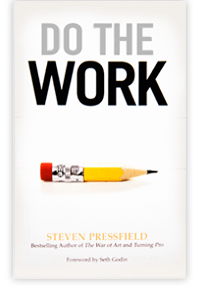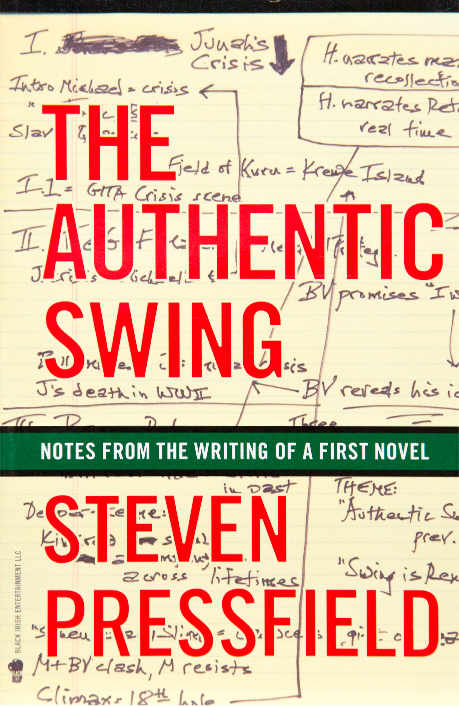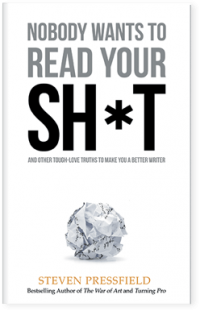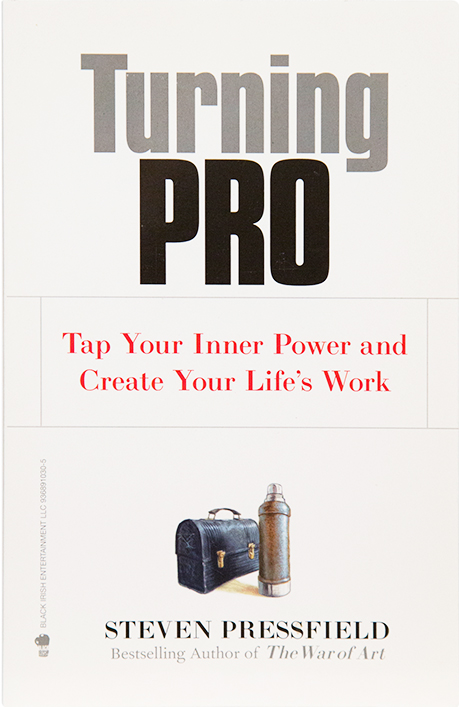Start At The End

Last week we were talking about first drafts (Cover the Canvas, 6/9/10). The idea was to get Draft #1 done from beginning to end, no matter what, even if it wasn’t perfect. The reason? Because once we’ve got a first draft, we’re re-writing, not writing. Writing is too freakin’ hard.
The obvious next question (or maybe it’s the preceding question) is: “Okay, but how do we decide what’s in the first draft?”
Work from back to front
Here’s a principle that screenwriters use: Start at the end.
Begin with the climax, then work backwards.
I’m a big fan of this method. It works for anything–novels, plays, new-business pitches, music albums, choreography. It works if you’re Lady Gaga, it works if you’re Mother Teresa.
First figure out where you want to finish. Then work backwards from there.
Why does this work? Because it forces us to answer the real nut-busting questions: What is this story about? Who’s the hero? Who’s the villain? When protagonist and antagonist clash in the climax, what does it mean? What do we really want to say?
Case study: “Rocky”
Remember the first Rocky? Let’s get inside Sylvester Stallone’s head (he wrote the script, as well as starring in the movie) and see how Starting At The End works.
Sly’s sitting at his typewriter. What, he asks himself, is the climax of this story? It can only be one thing: Rocky and Apollo Creed slug it out in the prize ring. Okay. But what actually happens in the ring?
Should Apollo wipe the floor with Rocky? No, too depressing–and the theme (a loser is always a loser) sucks.
How about if Rocky kayoes Apollo? Nah, unbelievable. And again the implied theme (a bum can become champ of the world) comes off like a fairy tale.
But wait, suppose Rocky gets the hell kicked out of him by Apollo (that’s certainly believable), but he somehow hangs so tough that the fight ends in a draw? In other words, Rocky can’t actually defeat the champ, but he can take the punishment. In doing that, he earns the respect of the boxing world–and of himself. That’s good! Sly perks up; he rolls a fresh sheet into the typewriter …
Sly writes what, to me, is the best scene in the movie: the Night Before the Big Fight scene.
Midnight: Rocky’s at home with Adrian in his hellhole apartment. He can’t sleep. He gets dressed and goes down to the arena. He walks in, alone. He sees the ring, the stands, the posters of Apollo, the gigantic American flag. It hits him: holy shit, this is real. He, a ham-and-egger from the streets, will be going toe-to-toe with the heavyweight champion of the world. Rocky exits, shattered.
Back home, with emotion, Rocky tells Adrian what he just saw and felt. He has no chance against Creed. He’s been kidding himself, even to entertain the thought. He’s gonna get massacred tomorrow; he’s going to look like a fool in front of the entire world.
Then: Rocky’s epiphany. He lets go of the dream of winning. Instead, he sets his aim–do or die–to last fifteen rounds. To take whatever punishment the champ dishes out–and to stay standing.
If I can do that … if I can go the distance with Creed … then I’m gonna know, for the first time in my life, that I weren’t just another bum from the neighborhood.
That’s it! That’s the theme. That’s Act One, that’s Act Two.
Working backward from the end, Sly the screenwriter has licked the story.
The end dictates the beginning
Act One and Act Two, Sly knows now, have to set up two elements:
First, that Rocky is a bum from the neighborhood–that everyone else believes this and that Rocky believes it too. Hence, Rocky’s job as a mob knee-breaker, his horrible apartment, “Take her to the zoo!”
Second, that within this man, whom the world sees as a bum, lies the potential to rise above his situation, to reclaim (or claim for the first time) his honor and self-respect. Hence, Mickey the trainer, the meat locker scene, the “Flying High Now” moment when Rocky races up the steps of the Philadelphia Museum of Art.
Once Sly figured out the climax, he had his theme. He knew what Rocky represented, what Apollo represented, what the fight, the neighborhood, what Adrian represented.
A principle of leadership
I’ve just finished a really interesting book, The Sinai Campaign by Moshe Dayan, the great Israeli general. Dayan, facing the Egyptian army in 1956, did the same thing Stallone did. He worked backwards from the end. He figured out what the Israeli Defense Forces needed to accomplish, politically as well as militarily, to extricate themselves from a dangerous situation (Egyptian terrorism, a blockade of the straits of Tiran, etc.) Then he figured out what actions were necessary to get to that place.
Another way to look at this principle is to think of it in terms of leadership. What service does a leader perform? A leader defines the goal. (In writing terms, he figures out the climax of the story; in biz terms, he articulates where the organization wants to go.) Then he turns to his colleagues and says, “Okay, ladies and gentlemen, figure out how to get us there.”
For us, as artists and entrepreneurs, we have to be the leader and the working stiffs. Part of us has to define the goal–what’s the finish? what’s the climax? where do we want this train to end up? The other part has to figure out what specific actions we need to take to get us there.
I’m not saying Start At The End is the only way to do this. But it’s a sound principle that applies across a whole range of disciplines. Work back-to-front. It works.





Superb advice. Applies to so much of what we do. Envisage – really see it – the outcome then define the steps to get there. You consistently have the measure of what you are trying to achieve as you proceed. This was a nice big click of a synaptic switch in my head as it resonated. I’ve managed projects like this and they’ve worked really well.
Thank you for reminding and embedding this again for me. Not just for artists and entrepreneurs.
That is such simple and effective advice that it strikes me as one of those a-ha moments in life.
For me, the problem with tackling the novel has been the question of “Where is this going?” That’s a truism for life, I feel, but you’ve reminded me of an obvious place to start with any project.
Start with the end in mind. Thanks for making the obvious more obvious.
A fantastic reminder of an indelible truth– figure out where we want to go before we go. Applying this as I start writing my next novel … Thank you, Jennifer King
Steven,
I’ve been reading your blog for a while. Great posts.
With regard to this one, have you heard of Eli Goldratt’s Theory of Constraints and what he calls current and future reality trees?
http://en.wikipedia.org/wiki/Thinking_processes_(Theory_of_Constraints)
With current reality trees you look at your current reality and ask: ‘what’s causing my current reality to be like it is?’, ‘what’s causing my life/job/project to be progressing in this way right now?’ and then: ‘what’s causing the causes?’ until you get to some underlying answer that will help you solve more than one non-desired current reality (problem).
With future reality trees, as you mention in your post, you start at the end with the desired end state and work backwards: “what comes directly before my desired outcome?” then “what comes before that?” etc, until you reach a connection point between your current reality and the chain of causes and effects that will take you towards your goal. Until you reach something that’s linked to your future goal but that you can actually do right now. Then you can start walking down the path to your goal.
Example:
—I want €1m in my bank account.
—What causes €1m to appear in my bank account?
—Somebody, or some bodies, will have to transfer €1m into my bank account, ’cause right now it’s at €0.
—What causes someone to transfer €1m into my bank account?
—Well, seen as €1m is the price they’re going to pay, you have to give them more than €1m in value. (Buffet’s ‘pay a dime for a dollar’ idea).
—So how do I do that?
—Create and sell €1m of value. Or 33,333 x €30 of value, or some other combination.
—So what makes something valuable? What do my clients/readers/supporters value?
—There are many different types of value.
—etc, etc…
…until you get to…
—paint a picture, write a book, organise an event, teach something, build something, etc. Help someone in some valuable way.
He also wrote a series of didactic business novels. The first one was called “The Goal”. You might find his ideas interesting when thinking about cause, effect and the attainment of goals.
I had never heard of that, Matthew, thanks for the intro. Very interesting stuff … and “didactic business novels” too. It don’t get no better than that!
Wow. Fantastic post. Helped me think about my current creative projects and my business in a new way. I really liked the Rocky movie analogy.
The problem now is I have a lot of thinking to do but that’s good.
Working back to front is a variation on the loose planning strategy that works for most creative endeavours. Don’t have a strict plan but be ready to digress if needed
Thanks for adding that zionist tidbit at the end. Yeah, we can all relate to that.
Excellent post. Stephen Covey recommends “begin with the end in mind.” One of my life tenets is the line from Alice in Wonderland: “If you don’t know where you’re going any road will get you there!” The task: know, then act.
Wow, ROCKY is one of my all-time favorite movies. I’ve seen it a gazillion times but every time I catch it on TV — or hear the music — it lifts my spirit. That dark night of the soul you write about, Steve, where Rocky knows he can’t win… but he can win by not quitting… is priceless. It’s a lesson for us all.
@anoni Fatuous remarks always most unwelcome.
One of my favorite “laws” from Greene’s 48 Laws of Power is Law 29 Plan All the Way to the End. This is a good take off that.
I like this post and wanted to add two things in support. One J.K. Rowlings had the last chapter of Harry Potter written before the first. Two, Tolkien wrote LOTR straight through, then got to mount Doom and had Gollem take the ring and fall into the fire. He then had to rewrite the whole thing! Oi!
Katherine
Very nice application of what we teachers call backward design: What knowledge do you want the students to walk out of the course with? What will the final assessment show? Then begin designing the curriculum, course or lesson backwards from that point.
You’re right on, Steven. The “back-to-front” method is a surefire way to focus and clarify a work, whatever it is. I’ve written a few books, but edited lots more. My first three questions to a client are: One, what is the purpose of this (novel, pamphlet, letter, memo, manual)? Two, who’s your audience, your readers? Three, what do you have to offer that’s important or of interest–why would anyone want to spend more than one minute looking at it? For viable answers, you have to start at (or at least know) the end, the objective, first.
So many people I’ve worked with think you need to start writing at the beginning and go till the end, starting with the Introduction. (But how can you introduce what you haven’t yet written?) What you’re saying is virtually a maxim for most creative disciplines: You begin where your reader/viewer finishes, and vice versa. Go Rocky!
Thanks for sharing this principle. I’ve realized that there are layers to this logic depending on how far you are zoomed in or out on your task, project, or life. Kind of like a fractal.
Thanks for your publication on the traveling industry. We would also like contribute that if you are one senior thinking of traveling, it really is absolutely important to buy travel insurance for seniors. When traveling, golden-agers are at high risk of experiencing a health emergency. Getting the right insurance package in your age group can safeguard your health and provide peace of mind.
As graphic as it may sound, skin peeling acne off your body can basically result in a smoother and more attractive skin quality and appearance.
Wonderful goods from you, man. I’ve keep in mind your stuff previous to and you’re just extremely excellent. I really like what you have obtained right here, really like what you’re saying and the way in which by which you are saying it. You make it enjoyable and you still take care of to stay it sensible. I can’t wait to learn much more from you. This is actually a tremendous site.
I’m now not positive where you’re getting your info, however good topic.
I must spend some time finding out much more or working out more.
Thank you for excellent information I was searching for this info for my mission.
I saw myself in your interview with Steven Pressfield. It was great! I ve read the War of Art and it spoke to me. I finally finished and published my book, Simple Ways to Transform Your Life: Lessons Learned by a Late Bloomer in December 2017. What a victory over Resistance! I retired from my full time work in June 2016 and have been trying to build a business (It s Never Too Late to Bloom!) as a Life Coach and learned in your conversation with Steven that I m not a Pro, but an Amateur and my old friend Resistance is alive and well. My question: Can I put my ass where my heart wants to be? I m the only one who has the answer to that one. It s back to B-School for me. Thanks Marie for what you do for us.!
The conclusion, outlook, and shortcomings section, as the concluding part of the graduation thesis, are often written last, and the workload of this section is relatively easy. It is generally recommended to add the shortcomings of this article (plus points), and it is also recommended to revisit the intro section after completing the conclusion section of the graduation thesis http://www.dissertation-master.com , as after months of in-depth research and logical reinforcement, The initial intro now appears to have some loopholes and shortcomings, and making modifications at this time can enhance the completeness and logicality of the graduation thesis.
Empower your ecommerce endeavors with GinkgoRetail’s specialized Order Management Software. Seamlessly integrated for online retail excellence, our software optimizes order processing, inventory management, and streamlined fulfillment. Tailored specifically for ecommerce, it ensures a cohesive and efficient workflow, enabling you to deliver a seamless buying experience. Elevate your online retail operations with GinkgoRetail’s Order Management software for Ecommerce, crafted to bolster the success of your ecommerce ventures.
Great perspective on starting with the end in mind—it’s such a powerful way to approach challenges! This mindset has helped me not only in creative projects but also in managing my skin health. For those struggling with conditions like psoriasis or eczema, setting a clear goal for healthier skin can guide you toward effective solutions. I’ve found uvb light therapy to be incredibly helpful, and the devices available at uvb-therapy.com are a fantastic option for home use. Having a tangible tool to work toward my goal has made all the difference!
Brand Van billige panerai ure Cleef amp ArpelsModel Lady Arpels Pont des AmoureuxDiameter 38mmCase Material White or rose gold with diamond-set bezelDial Color Enamel dials featuring a Parisian bridge scene at night during the day and throughout all four seasons six totalIndexes PaintedLume NoneStrapBracelet Either interchangeable Alligator strap or matching gem-set bracelet